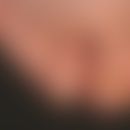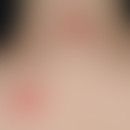Synonym(s)
DefinitionThis section has been translated automatically.
Normally, lichn ruber heals without consequences. A rare variant of lichn ruber (<1% of all lichn ruber cases) is characterized by severe vacuolated epithelial atrophy, possibly with focal hyperpigmentation. These cases tend to show an extensive pattern of lesions caused by confluence of the lesions (see Fig.). Preferably, the lower legs and feet are affected. In rare cases, atrophic healing stages can be observed even in longstanding classic lichen ruber.
In particular, however, anular lichen ru ber tends to central atrophy of the lesions.
Atrophy as a consequence of healing can also be observed in bullous lichen ruber.
Atrophies are also observed in lichen ruber infestation of the nails up to complete loss of the nails.
Furthermore, lichen ruber follicularis leads to follicular atrophy and focal hair loss at the capillitium.
Clinical featuresThis section has been translated automatically.
Mostly few, centrally sunken, 0.2-0.5 cm, but also confluent into larger anular plaques, brownish, occasionally bluish lesions with atrophic parchment-like surface. Loss of hair and follicular ostia.
Graham-Littlesyndrome: An enormously chronic variant of lichen ruber follicularis with follicular, acute keratotic lesions on the trunk, the typical clinical and histologic signs of lichen ruber, and (lymphocytic) scarring alopecia (lichen ruber follicularis capillitii) and scarring nail dystrophy is called Graham-Little syndrome.
You might also be interested in
HistologyThis section has been translated automatically.
Image of lichen ruber. The infiltrate is usually rather sparse. The epithelium is atrophic with striae.
Differential diagnosisThis section has been translated automatically.
TherapyThis section has been translated automatically.
LiteratureThis section has been translated automatically.
Arduino PG et al (2014) Pimecrolimus vs. tacrolimus for the topicaltreatment
of unresponsive oral erosive lichen planus: a 8 week randomizeddouble-blind
controlled study.J Eur Acad Dermatol Venereol 28:475-482Li B et al (2010) Annular atrophic lichen planus. Eur J Dermatol 20:842-843
Pandhi D et al. (2014) Lichen planus in childhood: a series of 316 patients.
Pediatric dermatol 31: 59-67.Sugashima Y et al. (2012) Annular atrophic lichen planus of the lip. Dermatol Online J 18:14
Incoming links (8)
Anonychie acquired; Erythema; Erythema dyschromicum perstans; Interface dermatitis; Lichen atrophique; Lichen plan sclèreux; Maculae atrophicae; Retiform parakeratosis;Outgoing links (8)
Graham-little syndrome; Lichen planopilaris; Lichen planus anularis; Lichen planus bullosus; Lichen planus classic type; Lichen planus follicularis; Lichen sclerosus (overview); Scleroderma (overview);Disclaimer
Please ask your physician for a reliable diagnosis. This website is only meant as a reference.









